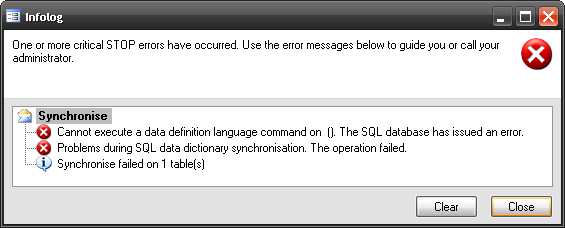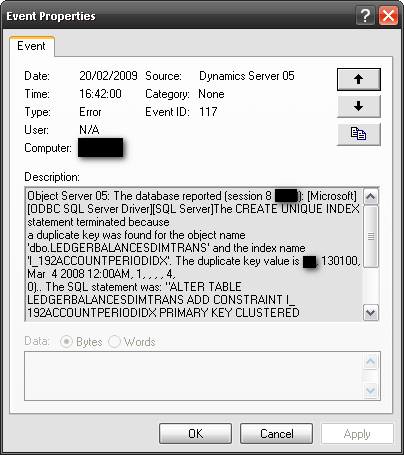You might get this error message following an upgrade:

Cannot execute a data definition language command on (). The SQL database has issued an error. Problems during SQL data dictionary synchronisation. The operation failed. Synchronise failed on n table(s)
To find out exactly what the problem is you will need to have a look in the Windows event viewer on the AOS server, which will look something like this:

If the error is similar to this (I.E of the family “The CREATE UNIQUE INDEX statement terminated because a duplicate key was found”) then you have the following options to solve the problem:
1. If you are not worried about the data in the table then the simplest solution is to drop the table
Otherwise:
2. In AX, temporarily disable the index (that causes the duplicate) and use the table browser with filters(using data from the event log) to correct the data.
or
3. Use SQL Server management studio to resolve the problem – see this microsoft knowledge base article for a great guide on how to do this: http://support.microsoft.com/kb/139444
=================================================================
=================================================================
Run the below job , in order to get the table name
static void forceDbSynchronize(Args _args)
{
Dictionary dict;
int idx, lastIdx, totalTables;
TableId tableId;
Application application;
SysOperationProgress progress;
StackBase errorStack;
ErrorTxt errorTxt;
;
application = new Application();
dict = new Dictionary();
totalTables = dict.tableCnt();
progress = new SysOperationProgress();
progress.setTotal(totalTables);
progress.setCaption("@SYS90206");
errorStack = new StackBase(Types::String);
lastIdx = 0;
try
{
for (idx = lastIdx+1; idx <= totalTables; idx++)
{
tableId = dict.tableCnt2Id(idx);
progress.setText(dict.tableName(tableId));
lastIdx = idx;
application.dbSynchronize(tableId, false, true, false);
progress.incCount();
}
}
catch (Exception::Error)
{
errorTxt = strFmt("Error in table '%1' (%2)", tableId, dict.tableName(tableId));
errorStack.push(errorTxt);
retry;
}
setPrefix("@SYS86407");
errorTxt = errorStack.pop();
while (errorTxt)
{
error(errorTxt);
errorTxt = errorStack.pop();
}
}














